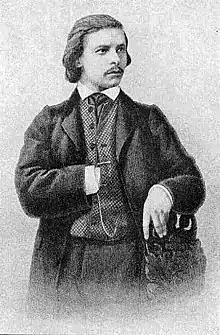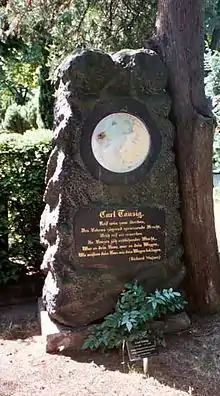Karl Tausig
Karl Tausig (sometimes "Carl"; born "Karol"; 4 November 1841 – 17 July 1871) was a Polish virtuoso pianist, arranger and composer. He is generally regarded as Franz Liszt's most esteemed pupil, and one of the greatest pianists of all time.

Life
Tausig was born in Warsaw to Jewish parents and received his first piano lessons from his father, pianist and composer Aloys Tausig, a student of Sigismond Thalberg. His father introduced him to Franz Liszt in Weimar at the age of 14. He quickly became a favorite pupil of Liszt's, travelling with him on concert tours and studying counterpoint, composition and orchestration in addition to his piano lessons.[1] At the age of 16 he met Richard Wagner, of whom he became a devoted follower and friend. He also became a great admirer and friend of Johannes Brahms. Tausig made piano arrangements of many of Wagner's operas. He also introduced to Wagner his friend Peter Cornelius, another Wagner devotee.
In 1858 Tausig made his debut in Berlin at a concert conducted by Hans von Bülow. While some critics admired his technical feats at the keyboard, others found his playing noisy and overbearing. Even some who were more accommodating of Tausig's "Lisztian eccentricities" felt he would play better as he matured.[2] Tausig toured through various German towns in 1859–60, making Dresden his base. He moved to Vienna in 1862; there he gave concerts of modern orchestral music, including some of his own symphonic poems. These concerts were only partially successful artistically and a failure financially. After staying out of public view for a few years, during which time he married pianist Seraphine von Vrabely (1841–1931), he began touring once again and was now considered a pianist of breadth and dignity of style.[2]

Tausig settled in Germany and opened a piano school in Berlin in 1865 which, however, closed soon afterwards. He toured throughout Europe, but the strain of travelling weakened his health. He died in Leipzig from typhoid at the age of 29.[2] His grave is preserved in the Protestant Friedhof III der Jerusalems- und Neuen Kirchengemeinde (Cemetery No. III of the congregations of Jerusalem's Church and New Church) in Berlin-Kreuzberg, south of Hallesches Tor.
Pianism
Tausig was considered by some critics to be the greatest of Liszt's pupils, pianistically speaking, and to carry pure virtuosity to heights only suggested by Liszt. Anton Rubinstein called him "the infallible."[3] Where Tausig differed from his teacher was in his lack of flamboyant gestures while playing. Tausig sat motionless at the piano and abhorred what he called Spektakel. While his fingers were working miracles at the keyboard without any digital errors, the only sign of tension from Tausig would be a slight tightening of one corner of his mouth.[4]
Until his untimely death, some critics surmise that Tausig may not have had a pianistic equal, combining Liszt's force and range of tone color with the intellectuality of his fellow pupil Hans von Bülow. Another Liszt pupil, Eugen d'Albert, compared Tausig very favorably with their teacher. He said that while Liszt's musical conceptions were grander, Tausig possessed a better and more accurate technique coupled with a good deal of poetry.[5]
Repertory
Tausig's repertory was extensive; he could play from memory works ranging from Scarlatti to Liszt. He was especially noted for his interpretations of Chopin, Weber and Beethoven, both for pianistic finish and intensity of emotion.[2]
Works
Karl Tausig's output as composer is quite small. As well as entirely original works, he arranged for piano music of a number of composers, and wrote a number of pedagogic works (works for teaching and practice).
In the following list, unpublished works are shown. Some further works are also unpublished or lost, and are not listed. Besides the transcriptions of eight Liszt symphonic poems listed here, Tausig also arranged another three, but the manuscripts are not sufficiently intact to be accessible. See Dennis Hennig's article in the Liszt Society (UK) Journal volume 17 (1992), p.65 for more details. Some works were left incomplete by Tausig; where possible, details of the state of the manuscript are given.
All works listed are for piano solo unless indicated otherwise.
[This list is incomplete and may contain inaccuracies; please help to complete it.]
Original compositions:
- Impromptu, in F minor, Op. 1 [Op. 1a] (by 1855)
- Deux Études de concert (Two Concert Etudes), Op.1 [Op. 1c] (published 1871):
- No. 1: Presto appassionato in F-sharp major
- No. 2: Moderato in A-flat major
- Das Geisterschiff (The Ghost Ship), "Ballade for orchestra" [lost]
- Das Geisterschiff, Ballade, transcription for piano, in A minor/D major, Op. 1 [Op. 1b] (by 1860)
- Introduction and Tarantella, in A minor, Op. 2 [Op. 2a] (by 1855)
- L'Éspérance (Hope), Nocturne varié, in A-flat major, Op. 3 [Op. 3a] (by 1856)
- Sérénade, Op. 4 [publication lost?]
- Rêverie, in A major, Op. 5 [Op. 5a] (by 1856)
- Le Ruisseau (The Brook), Etude, in A major, Op. 6 [Op. 6a] (by c1862)
- Ungarische Zigeunerweisen (Hungarian Gypsy Airs), in B minor/major (by 1867)
- Concerto for Piano and Orchestra [lost]
- Tägliche Studien für Pianoforte von Tausig-Ehrlich (Honest Tausig's Daily Exercises for Piano) (published 1873) (American revised edition with additional exercises by "H. Ehrlich" published 1880):
- Vol. 1:
- Exercises with motionless hands. (#1–26)
- Exercises with the hands in progressive motion. Turning the fingers over and under. (#27–51)
- Vol. 2:
- Studies in Chords. (#52–68)
- Stretching exercises. (#69–76)
- Wide Jumps. (#77–84)
- Double-Notes. (#85–100)
- Scales in thirds in all major and minor keys. Chromatic scales with double-notes. (#101–102)
- Six Exercise Pieces. [called Préludes in the American revised edition (with 4 additional Préludes by "H. Ehrlich")]:
- No. 103: Moderato in E-flat minor
- No. 104: Allegro in E-flat major
- No. 105: Allegro moderato in C minor
- No. 106: Allegro in A major
- No. 107: Andante in F-sharp major
- No. 108: Moderato in D-flat major
- Octave-exercise. (#109)
Paraphrases, Fantasies, Elaborations:
- Gnomenchor und Sylphentanz, aus Fausts Verdammung, (from the Damnation of Faust) (Berlioz)
- Chopin's Étude (Op. 25 No. 2), transcription in double notes [lost]
- A selection of studies from Clementi's Gradus ad Parnassum
- Réminiscences de Halka, de St. Moniuszko. Fantaisie de concert, (Fantasie Halka. Oper von Moniuszko), Op. 2 [Op. 2b] (by 1860)
- Der Kontrabandiste (The Smuggler), from Spanisches Liederspiel (Op. 74 No. 10) (Schumann), "transcribed for concert performance"
- Nouvelles soirées de Vienne: Valses-Caprices d'après J. Strauss (Waltz-Caprices Nos. 1–3 [First Suite]) (1862):
- No. 1: Nachtfalter (Moth Waltzes, Op. 157)
- No. 2: Man lebt nur einmal (You Live Only Once!, Waltzes, Op. 167)
- No. 3: Wahlstimmen (Election Waltzes, Op. 250)
- Nouvelles soirées de Vienne: Valses-Caprices d'après J. Strauss (Waltz-Caprices Nos. 4 and 5 [Second Suite, posth.]):
- No. 4: Immer heiterer (Always Cheerful Waltzes, Op. 235) and Wiener Chronik (Vienna Chronicle Waltzes, Op. 268)
- No. 5: (in A Major)
- Kaiser-Marsch (WWV 104) (Wagner)
- Wagner: Vorspiel (Prelude) to Die Meistersinger von Nürnberg, for solo piano
- Wagner: Vorspiel (Prelude) to Die Meistersinger von Nürnberg, for piano four-hands
- Meditation from Die Meistersinger von Nürnberg (Wagner)
- Rich. Wagner: 'Tristan und Isolde', Drei Paraphrasen (3 Paraphrases on Wagner's opera) (c1865):
- No. 1: Liebesscene - Verklärung (Love Scene & Transfiguration)
- No. 2: Brangänens Gesang - Matrosenlied (Brangäne's Song & Sailors Shanty)
- No. 3: Melodie des Hirten (The Sheep Herders Melody)
- Two "Free Transcriptions" from Die Walküre (Wagner):
- Siegmunds Liebesgesang (Siegmund's Love Song)
- Der Ritt der Walküren (The Ride of the Valkyries)
- Der Ritt der Walküren von Richard Wagner, for piano four-hands
- Weber: Aufforderung zum Tanz, Mit Arabesken für den Concertvortrag (Invitation to the Dance), "with arabesques for concert performance", concert arrangement for piano
Transcriptions, Adaptations, Piano scores:
- Bach: Toccata und Fuge in D minor (BWV 565), transcription for piano ("concert arrangement")
- Bach: 6 Chorale Preludes:
- No. 1: Wir glauben all' an einen Gott, Schöpfer (BWV 680)
- No. 2: Das alte Jahr vergangen ist (BWV 614)
- No. 3: O Mensch, bewein' dein' Sünde gross (BWV 622)
- No. 4: O Lamm Gottes, unschuldig (BWV 656)
- No. 5: Vater unser im Himmelreich (BWV 737)
- No. 6: Meine Seele erhebt den Herren (BWV 648)
- Bach: Praeludium, Fuge und Allegro in E-flat major (BWV 998)
- Beethoven: Sechs Sätze aus Streichquartetten (6 Pieces from String Quartets), transcriptions for piano:
- No. 1: Adagio (Op. 59 No. 1, 3rd mvt)
- No. 2: Scherzo (Op. 59 No. 2, 3rd mvt)
- No. 3: Andante (Op. 59 No. 3, 2nd mvt)
- No. 4: Cavatina (Op. 130, 5th mvt)
- No. 5: Presto (Op. 131, 5th mvt)
- No. 6: Scherzo (Op. 135, 2nd mvt)
- Chopin: Piano Concerto No. 1 in E minor (Op. 11), transcription for solo piano
- Liszt: Faust Symphony (Gretchen incomplete, remainder mostly complete; unpublished)
- Liszt: Dante Symphony (unpublished)
- Liszt: Ce qu'on entend sur la montagne (unpublished)
- Liszt: Tasso (essentially complete, only last 4 bars not finished; unpublished [ms in Library of Congress])
- Liszt: Les préludes (Published by Editio Musica Budapest)
- Liszt: Orpheus (no phrasing, dynamics or tempo markings; unpublished)
- Liszt: Festklänge (unfinished)
- Liszt: Heroïde funèbre (no phrasing, dynamics or tempo markings; unpublished)
- Liszt: Hungaria (last 13 bars incomplete; unpublished)
- Liszt: Hamlet (unpublished)
- Liszt: Die Ideale (last 25 bars incomplete; unpublished)
- Scarlatti: Five Sonatas, "concert arrangements" for piano from the original harpsichord pieces:
- No. 1: Pastorale (in E minor K. 9)
- No. 2: Capriccio (in E major K. 20)
- No. 3: (in G minor K. 12)
- No. 4: (in G minor K. 426)
- No. 5: (in F minor K. 519)
- Scarlatti: Keyboard Sonata in C major (K. 487)
- Schubert: Militär-Marsch (Military March) No. 1 in D (Op. 51 No. 1), transcription for solo piano ("concert arrangement")
- Schubert: Polonaise (Op. 75 No. 3), transcription for solo piano
- Schubert: Andantino und Variationen (Andantino and Variations) & Rondo, über französische Motive (Rondo, on a French Theme) (Op. 84 Nos. 1–2), transcriptions for solo piano ("concert arrangement")
Recordings
Michael Ponti was the first to record an all-Tausig album, in the 1970s on the Candide LP label. Artur Cimirro recorded an album containing some of Tausig's original compositions, for the Acte Préalable CD label.[6] Dennis Hennig has released three all-Tausig albums for the Etcetera label: all five of the Valse-Caprices and the three Schubert transcriptions, an album of Tausig's Wagner transcriptions including the four-hand version of Ride of the Valkyres, and four of Tausig's transcriptions of Liszt symphonic poems.
Historically, Tausig's arrangement of Strauss's waltz You Only Live Once! was recorded by Sergei Rachmaninov and Ignacy Jan Paderewski. Rachmaninov also made recordings of Tausig's transcription of Schumann's Der Kontrabandiste and Tausig's Pastorale in E minor, adaptated from Scarlatti's harpsichord Sonata, L. 413, the latter also being popular with several other pianists of that era. The Bach Toccata and Fugue in D minor adaptation and the Schubert/Tausig Marche Militaire were also quite popular in recordings, the latter being recorded by Egon Petri, among others.
Notes
- Dannreuther, New Grove (2001), 25:125–126.
- Dannreuther, New Grove (2001), 25:126.
- Quoted in Schonberg, 256.
- Schonberg, pp. 256–59.
- Schonberg, p. 261.
- Karol Tausig - Complete Original Piano Works; Artur Cimirro, piano; Acte Préalable AP0359; 2016.
References
- Dannreuther, Edward, ed. Stanley Sadie, "Tausig, Carl [Karol]," The New Grove Dictionary of Music and Musicians, Second Edition, 29 vols. (London: Macmillan, 2001). ISBN 1-56159-239-0.
- Schonberg, Harold C., The Great Pianists (New York: Simon & Schuster, 1987, 1963). ISBN 0-671-64200-6.
External links
- Works by or about Karl Tausig at Internet Archive
- Free scores by Carl Tausig at the International Music Score Library Project (IMSLP)
- http://www.bach-cantatas.com/Lib/Tausig-Carl.htm
- http://jewishencyclopedia.com/view.jsp?artid=86&letter=T
- https://web.archive.org/web/20081226041025/http://www.usc.edu/dept/polish_music/PMJ/issue/6.1.03/greatestpianists.html
- . New International Encyclopedia. 1905.
- . Encyclopedia Americana. 1920.